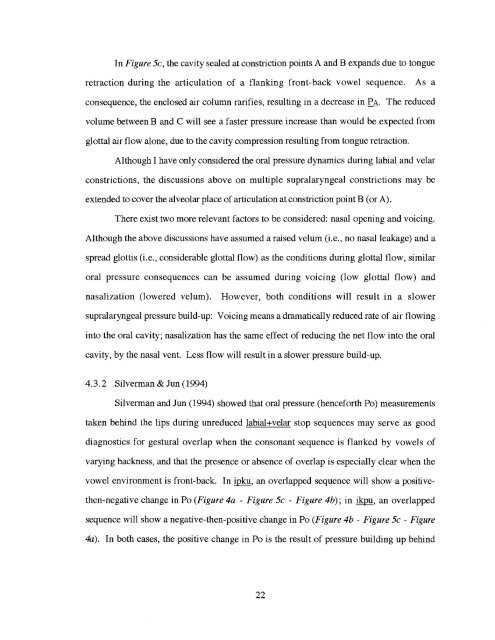A Phonetically-Based Optimality Theoretic Account of Consonant ...
A Phonetically-Based Optimality Theoretic Account of Consonant ...
A Phonetically-Based Optimality Theoretic Account of Consonant ...
You also want an ePaper? Increase the reach of your titles
YUMPU automatically turns print PDFs into web optimized ePapers that Google loves.
In Figure 5c, the cavity sealed at constriction points A and B expands due to tongue<br />
retraction during the articulation <strong>of</strong> a flanking front-back vowel sequence. As a<br />
consequence, the enclosed air column rarifies, resulting in a decrease in PA. The reduced<br />
volume between Band C will see a faster pressure increase than would be expected from<br />
glottal air flow alone, due to the cavity compression resulting from tongue retraction.<br />
Although I have only considered the oral pressure dynamics during labial and velar<br />
constrictions, the discussions above on multiple supralaryngeal constrictions may be<br />
extended to cover the alveolar place <strong>of</strong> articulation at constriction point B (or A).<br />
There exist two more relevant factors to be considered: nasal opening and voicing.<br />
Although the above discussions have assumed a raised velum (i.e., no nasal leakage) and a<br />
spread glottis (i.e., considerable glottal flow) as the conditions during glottal flow, similar<br />
oral pressure consequences can be assumed during voicing (low glottal flow) and<br />
nasalization (lowered velum). However, both conditions will result in a slower<br />
supralaryngeal pressure build-up: Voicing means a dramatically reduced rate <strong>of</strong> air flowing<br />
into the oral cavity; nasalization has the same effect <strong>of</strong> reducing the net flow into the oral<br />
cavity, by the nasal vent. Less flow will result in a slower pressure build-up.<br />
4.3.2 Silverman & Jun (1994)<br />
Silverman and Jun (1994) showed that oral pressure (henceforth Po) measurements<br />
taken behind the lips during unreduced labial+velar stop sequences may serve as good<br />
diagnostics for gestural overlap when the consonant sequence is flanked by vowels <strong>of</strong><br />
varying backness, and that the presence or absence <strong>of</strong> overlap is especially clear when the<br />
vowel environment is front-back. In ipku, an overlapped sequence will show a positive<br />
then-negative change in Po (Figure 4a - Figure 5c - Figure 4b); in ikpu, an overlapped<br />
sequence will show a negative-then-positive change in Po (Figure 4b - Figure 5c - Figure<br />
4a). In both cases, the positive change in Po is the result <strong>of</strong> pressure building up behind<br />
22
















